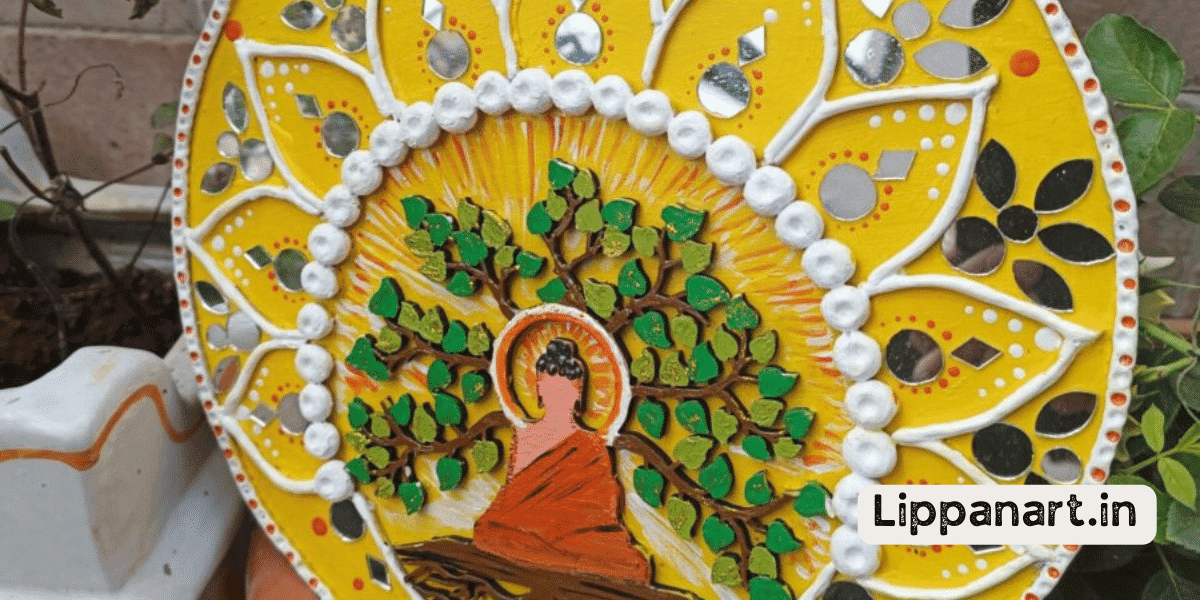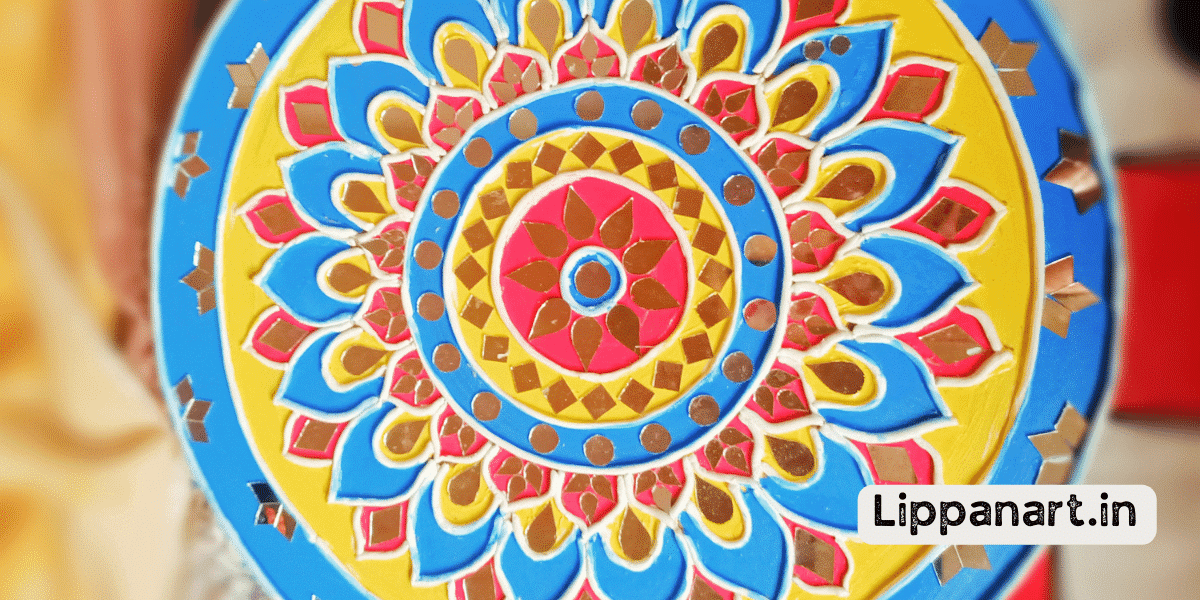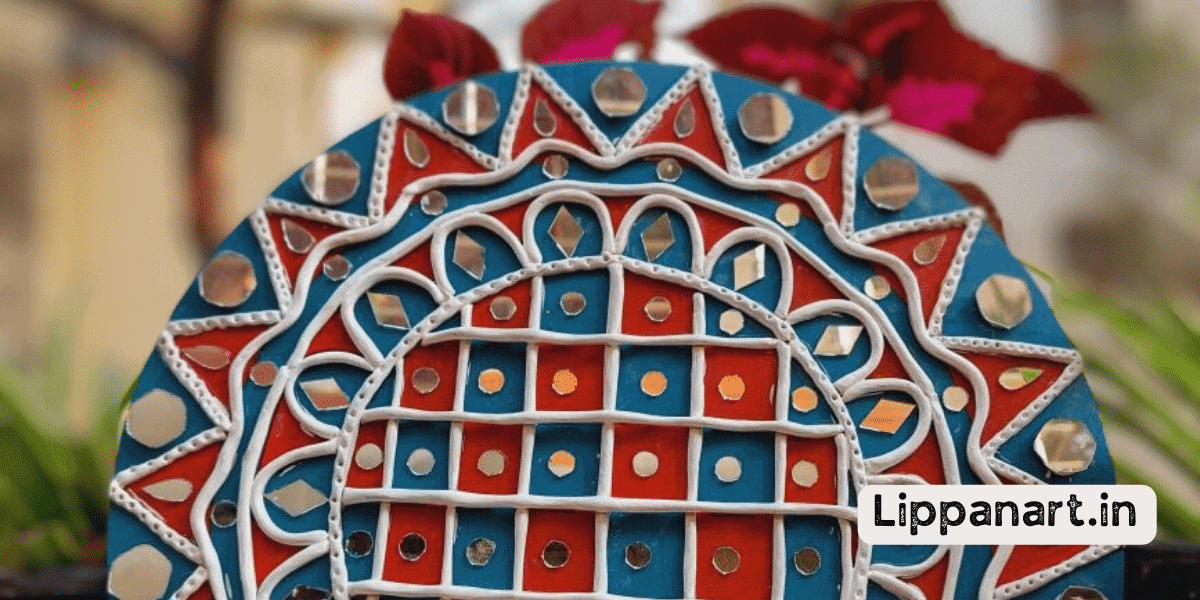You may be wondering: What is Lippan art?
Well, if you’re looking for an exciting and innovative way to express your creativity, this ancient Indian art form is the perfect place to start.
Lippan art is an incredibly unique form of art that involves creating intricate designs with mud, clay, and mirrors.
In this article, you’ll learn all the basics of lippan art and gain the confidence to create your masterpieces!
Introduction to Lippan Art
Lippan art is a traditional form of Indian art made with mud and mirrors. It is an innovative form of art that has been around for centuries and is still practised in many parts of India.
The art form creates intricate designs and patterns with natural materials such as mud, straw, and mirrors. The mirrors are usually set in the mud to create a reflective look that adds to the beauty of the design. The designs often feature motifs from Hindu mythology and are used to decorate walls, doorways, and other surfaces.
Art can adorn any space, from a home to an office, and it is often used to bring a sense of peace and harmony. Lippan art is a great way to bring a unique touch to any environment, and it is a great way for beginners to explore the traditional art form.
Creating timeless and breathtaking art pieces is achievable for anyone with just a few basic materials.
Materials Needed for Lippan Art
To create lippan artwork, you’ll need a few materials, including clay, paint, and brushes. But to make your piece truly unique, you should consider adding some items specifically used in lippan art, like camel dung and glue-cut mirrors.
Camel dung is a key material used in lippan art. It is mixed with clay to create mud, which is applied to the wall or canvas.
Glue-cut mirrors are another essential material used for lippan art. These mirrors are cut into various shapes and then glued onto the mud in a decorative pattern.
Also needed are paint and brushes. Pigment made from natural ingredients is the most traditional paint, but you can also use acrylic or poster paint. Different-sized brushes are needed to create the intricate and delicate designs that are often seen in lippan art.
With the right materials, you can create your lippan artwork! All you need is some creativity and imagination. With the help of the materials needed for lippan art, you can create unique pieces that will last for years to come.
Preparing the Surface for Lippan Art
If you’re ready to start your lippan art project, the first step is to prepare the surface. This process is critical to ensuring your artwork succeeds and lasts for years.
Here are four key elements to keep in mind before getting started:
- Choose the right walls: It’s important to select a wall that is smooth and free from any bumps or cracks that could interfere with the design of your lippan art.
- Choose the right paints: Always use high-quality, light-fast paints designed specifically for creating lippan art to ensure the best results.
- Select the right materials: You’ll also need other materials, such as glue, chalk, and clay, to create your lippan art.
- Start with a blank slate: It’s crucial to ensure the wall is free of debris and properly cleaned.
By taking the time to prepare the surface properly, you will be well on your way to creating a stunning piece of lippan art that will last for years to come! You can create eye-catching artwork that will wow your family and friends with the right materials, paints, and walls.
Unleash your creativity and start your lippan art project today!
Basic Techniques in Lippan Art
Developing your lippan art skills doesn’t have to be intimidating – there are plenty of simple techniques that even beginners can master. Whether you want to create a unique pattern, product, or design, the basic techniques of lippan art will get you started. Different types of lippan art require different techniques, so it’s important to understand the basics.
| Technique | Description |
|---|---|
| Moulding | Lippan art uses a mould made from clay or plaster. |
| Stroking | The mould is stroked with a thin layer of mud or clay. |
| Drying | The mud or clay is then allowed to dry out before layering. |
| Layering | Different colours and shapes are layered on top of the mould. |
The end product will be determined by the colours, shapes, and patterns used in the layering process. Experiment with different colour combinations and shapes to find the perfect combination for your unique product. With some practice, you can create beautiful lippan art pieces you can be proud of.
Innovative lippan art is all about having fun and being creative. So, don’t be afraid to take risks and try something new. With practice, you’ll soon be able to create interesting patterns and designs that will impress.
- Editor’s Choice
- Best Seller
- Amazon Choice
Creating Geometric Patterns in Lippan Art
Creating geometric patterns in lippan art is an exciting way to add interest and texture to your work. Here are a few tips to get you started:
- Experiment with mirror shapes to create symmetrical designs.
- Get creative with colour, hues, and different textures.
- Consider the design conception before beginning a project.
- Don’t be afraid to go outside of the box!
Geometric patterns in lippan art add extra complexity to your projects. Utilize mirror shapes to create symmetrical and interesting designs. Mix different colours, hues, and textures to make your artwork stand out. Consider the design conception before beginning a project, and don’t be afraid to think outside the box. You can quickly create unique and innovative geometric patterns with a little practice!
Adding Texture and Detail to Lippan Art
Adding texture and detail to your artwork can take it to the next level! You can use various materials to make your lippan art unique and mesmerizing. For example, you can use strips of mirror art to add an interesting visual component or acrylic paints to create a beautiful mural wall decor. Adding texture and detail to your lippan art can make something that stands out and creates an emotional response in the audience.
| Material | Visual Effects | Impact |
|---|---|---|
| Mirror Art Strips | Eye-catching, reflective | Captures attention |
| Acrylic Paints | Vibrant, dynamic colours | Inspiring |
| Decorative Stones | Mesmerizing, unique | Engaging |
The possibilities are endless for adding texture and detail to your lippan art. To achieve a distinct appearance, you can blend various materials. For example, you can combine decorative stones with acrylic paints to create a mesmerizing mural wall decor. Whatever you choose, make sure your design is innovative and will capture the audience’s attention. With the right materials, you can create something truly unique and inspiring.
Choosing Colors and Paints for Lippan Art
Choosing the right colours and paints for your lippan art can make a huge difference in the finished product. To ensure you create the best artwork, it’s important to select paints that are easy to work with and provide vibrant colours.
Here are some tips to consider when choosing colours and paints for lippan art:
- Select materials that are specifically designed for this art form.
- Look for manufacturing materials that are email-friendly.
- Use paints specifically designed for lippan art to ensure vibrant colours and textures.
- Opt for paints that are easy to use, durable, and come with a stick.
By following these tips, you can ensure you have the right materials for your lippan art. Experiment with different colours and paints to find what works best for you.
You can create beautiful, innovative lippan art that stands out with the right colours and paints.
Finishing and Sealing Lippan Art
Once the lippan art is complete, finishing and sealing it for protection is important. Depending on the art material list used, there are a few different ways to go about this.
Lacquer, shellac, and varnish are all popular choices. Lacquer is a great option for protecting lippan art from water and moisture damage. It is also relatively easy to apply. Shellac is excellent for preserving the colours of the lippan art and can be applied with a brush or a spray. Varnish is a more durable option, but it takes longer to apply.
Whichever type of finish or seal you choose, it’s important to apply it correctly. Take your time and make sure you have a smooth, even finish. Use a brush or roller for a more even finish if you need to. After the seal is applied, it is important to let the art dry thoroughly before displaying it.
Once the lippan art is finished and sealed, your art is ready to be displayed and enjoyed. Finishing and sealing lippan art is an important part of the creative process, so take your time and enjoy the journey. With some practice and patience, anyone can craft something distinctive and exquisite.
Displaying and Caring for Lippan Art
After sealing and finishing your lippan art, it’s time to display and care for it. Showcase this unique and intricate art form to your entire community with these simple tips:
- There are two options for displaying this item – To display the intricate patterns and animal forms perfectly, it’s best to hang it on a wall or place it on a designated shelf.
- Use white paint to touch up any wear and tear or damage. It’ll keep your lippan art looking fresh and vibrant.
- Place it away from direct sunlight to prevent fading. Take advantage of the LED lighting to keep your lippan art looking beautiful.
- Store it correctly and safely. Wrap it in acid-free paper and store it in a cool, dry place to keep your lippan art safe and preserved.
Creative and innovative, lippan art is an engaging way to add a unique flair to your home. With these simple tips, you can display and care for your lippan art like a true professional, showing off its intricate pattern and animal form to the world.
Tips and Tricks for Beginner Lippan Artists
For those just getting started in the world of lippan, there are some tricks and tips to help make the process easier. India has a long tradition of Lippan Art, and many resources are available to make it easier to learn the basics. One of the best starter kits for beginners is a Lippan Art Kit, which includes the simple materials needed to get started.
Here are some tips and tricks to help beginner Lippan artists:
| Materials | Tips |
|---|---|
| Simple Materials | Experiment with different materials to identify the best ones for your purposes. |
| Coloured Foils | Use different coloured foils to make your designs stand out. |
| Glue | Use the correct amount of glue for the desired effect. |
| Paintbrush | Use a paintbrush that is the right size for your project. |
| Stencils | Use stencils to create intricate designs quickly and easily. |
With the right materials and tips, you can easily create beautiful and unique Lippan art. So be creative and take advantage of the amazing resources available to you. By dedicating some time to practice and experimentation, you can achieve mastery in this traditional art form originating from India.
Frequently Asked Questions
What Is the Best Way to Store Lippan Art?
The best way to store lippan art is to keep it in a cool, dry environment. Avoid direct sunlight and humidity. Use acid-free boxes with acid-free tissue paper to prevent damage. Ensure the boxes are sealed tight and backed with cardboard for extra protection.
Is It Possible to Make a Living as a Lippan Artist?
Yes! You can make a living as a lippan artist with creativity and dedication. Innovate to stand out and develop your unique style to make your mark. It takes hard work, but the rewards are great.
Are There Any Tips for Creating Larger Scale Lippan Art Pieces?
You can create larger-scale lippan art pieces using larger materials like wooden boards or metal sheets. Experiment with different tools and techniques to find the best results. Think innovatively, and don’t be afraid to try something new!
Are There Any Tips for Making Lippan Art Pieces Last Longer?
Protect your lippan art pieces with a clear sealant, which will help ensure that colours don’t fade and edges remain intact. Apply a few coats for maximum longevity.
Are There Any Ways to Recycle or Repurpose Used Lippan Art Materials?
Absolutely! Recycling and repurposing lippan art materials is a creative and cost-effective way to extend their life. Transform used pieces into unique works of art by upcycling and combining them with other materials. Innovate with imagination and ingenuity to make something entirely new!
Conclusion
You’ve come a long way in learning the basics of Lippan art. You’ve explored the needed materials, practised the techniques, and made beautiful artwork.
As you continue to practice the art of Lippan, you may wonder if there’s any truth to the theory that the more you put into it, the more you get out of it. Investigate your work and see what truths you uncover.
You can take your Lippan art to the next level with patience and dedication.











